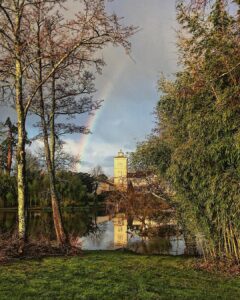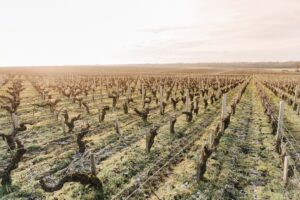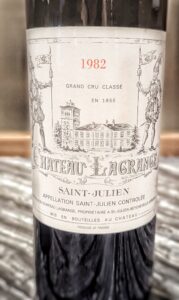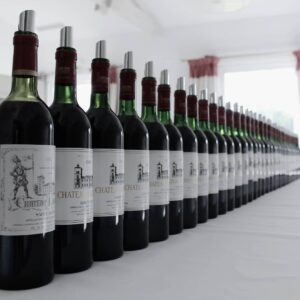The young French boy was wholly enthralled in his parents’ conversation during dinner, which was very unusual as, most of the time, he was trying to figure out a way to sneak out as soon as possible to get more play time in before bedtime. But this night was different as they lived in a small community in Bordeaux, France, where most of the time, talk at the table was about neighbors, family, or bills, as the little boy’s world was very tiny and the rest of the world seemed so far away. But there was a Japanese man who was the son of the founder of one of the oldest alcoholic beverage distribution companies in the world, Keizo Saji, and he had just bought a Third Growth classified château in the Saint-Julien appellation of the Haut-Médoc in Bordeaux, called Château Lagrange.
The French boy’s parents were not in the wine business so it was odd for them to talk about it but the idea of an Asian company buying the estate scared his parents yet fascinated the little boy.
The end of the 1970s and early 1980s were a financially difficult time for the Bordeaux wine region as despite them being the most famous fine wines in the world, the cost of running the châteaux, vineyards and investment needed for new wineries had escalated to the point that many of the producers were hemorrhaging money. So, some of the classified growths were forced to sell their grand estates. The idea that the successful Japanese company, Suntory, would purchase one of the classified growths for ten million US dollars seemed extraordinary as despite it being nothing compared to what châteaux cost today, it was an unfathomable amount of money to the local people at the time. Amazingly, they invested 30 million dollars into renovating the whole property and buying all the tools they needed to achieve excellence.
Two Sides Of The Same Coin
Today, French and Japanese cultures go hand in hand as they are both known for their fierce dedication to reaching as close to perfection as possible; back in the 1800s, the French chef Escoffier codified the five mother sauces and simplified French techniques that would become the basis for Western fine dining cuisine for decades. But it was the Japanese top chefs who eventually dazzled their French counterparts as despite the aesthetics and ingredients being different, its outstanding quality was undeniable. The Japanese discipline to achieve excellence, for example, forces one who wants to become a sushi chef to study making rice for three years with a total of ten years of study, which was immensely admirable to the French and would inspire admiration worldwide.
Keizo Saji kept everything French at Château Lagrange as he greatly respected the culture; he would use his resources and deep respect for Château Lagrange to bring it to its full potential. Keizo Saji was not only an important businessman but also a renowned Haiku poet and a second-generation master blender of Japanese whisky, his father was Japan’s first master blender. And so, at a recent Château Lagrange tasting of some of the best vintages over the past 40 years in New York City, it was an excellent opportunity to see if there was a significant quality improvement over the years.
Vertical Of Château Lagrange
Matthieu Bordes, the current general manager of Château Lagrange, talked about what drew Mr. Keizo Saji to purchase the property in the early 1980s before he led the vertical tasting. “Mr. Saji knew that land was the key point; to make a great wine, you must have a great terroir,” noted Matthieu. He further explained an interesting aspect of the vineyard situation of the classified growths in the Haut-Médoc of Bordeaux: the châteaux were classified in 1855 according to the value of their wines at the time and the vineyards were not classified. What this means, in reality, is that a château that was awarded the highest classification of a First Growth was given such a placement based on the wine they made from the vineyards in 1855. Still, since the château name holds the classification, it is allowed to expand the vineyards which go into its top selection wine as long as it is within its appellation. So hypothetically, a Second Growth châteaux in Saint-Julien can source its grapes from anywhere in the Saint-Julien delimitated area, over 2,000 acres of vineyards, and place it into its Second Growth classified wine.
Matthieu explained, “Mr. Saji noticed that the vineyards for Lagrange hadn’t changed in almost 400 years as the whole vineyard is one block around the château, located on the highest point of the land.” Today, Château Lagrange has only bought additional vineyards to make white wine. However, they haven’t purchased any vineyards to go into their Third Growth classified red wine, as it is still the same estate vineyard established in 1631.
First, the vertical started with the enchanting 2016 vintage, dancing along the palate with its aromatic beauty and fine texture. The 2010 and 2009 – the dueling superstar vintages back to back, the more structured, broad-shouldered giant next to the plusher, more accessible seducer, respectively, then the highly structured 2000 and more accessible 1990, showing that both are aging gracefully with even the 1990 still having a lot of life. And last, the 1982 is a legendary vintage for many reasons.
The 1982 vintage began a new age for Bordeaux wines, heralding the modern style of wines we know today. Since the vintage had consistently warm, dry weather, the grapes achieved a balanced ripeness. As before, it was a common practice, not only in Bordeaux but also in many wine regions in France, to add sugar to unfermented grape must that would then all be fermented to produce a higher alcohol wine – a process called chaptalization because in the past, Bordeaux had a problem with underripe grapes that produced wines that were so low in alcohol that they were unbalanced. Many top Bordeaux experts have said there hadn’t been such a consistent level of high-quality wines across Bordeaux since the extraordinary 1961 vintage. Since the 1982 vintage, Bordeaux has had a multitude of vintages that, despite differing in specific traits, have excellent quality wines across the region.
1982 was also a vintage that increased interest in a much broader audience around the world as Bordeaux was no longer just for a select group of people who had come from a family drinking Bordeaux for years and had the resources to cellar it for several decades; these wines now showed their deliciously intriguing qualities earlier, so one could understand its worth without having had the privilege of growing up with these wines. And it was no longer vital to cellar wines that were undrinkable in their youth, although they still age for decades as the structure is still there because it is a finer structure with less green notes that no longer dominate but instead add a nice nuance in the background.
Even with 1982 being an outstanding vintage, there was a gigantic leap in quality from that point to the 2016 vintage of Lagrange, as more money was placed into properly taking care of the vineyard as well as technology that would help to preserve the quality of the grapes coming into the winery.
On The Threshold
The nine-year-old boy was playing with his friends, running through the vineyards during harvest time as it was always the most exciting time of year in the normally sleepy little town tucked away in Bordeaux. All of a sudden, the sound of a plane was heard overhead; he started running under it, pretending he could leap up in the air and desperately grab on, traveling to an exciting destination as it seemed he would be like everyone else in his family – never stepping foot outside of Europe.
This harvest seemed like every other harvest to this little boy as he had no idea that the 1982 vintage would change his world forever. The following year, his parents would be talking about a prestigious Japanese company buying one of the classified growths and over two decades later, he would be traveling the globe as the general manager of that prestigious estate. Such a partnership between Suntory and Château Lagrange would become a beautiful symbiotic relationship as the great Keizo Saji knew it was a precious jewel that had become tarnished over time, needing someone to bring back its sparkle and preserve it at all costs. His legend lives on with this legendary property.
***Link to original article published on Forbes: https://www.forbes.com/sites/cathrinetodd/2023/12/21/revisiting-top-wine-vintages-from-bordeaux-starting-with-outstanding-1982
2016 Château Lagrange, Saint-Julien, Bordeaux: 70% Cabernet Sauvignon, 24% Merlot and 6% Petit Verdot. An enchanting wine that dances and prances on the palate with remarkable agility and grace with an incredible bouquet of violet, sandalwood incense and forest floor notes that has a stunning purity of fruit on the palate with redcurrants and blackberries, and the silky tannins caress the palate; such a beauty.
2010 Château Lagrange, Saint-Julien, Bordeaux: 75% Cabernet Sauvignon and 25% Merlot. Enthralling aromas of intense minerality, fresh morel mushrooms, and an Asian spice box with broad-shouldered tannins that give lots of lift and structure to this wine and marked acidity that all give this wine an incredible depth of flavor, complexity and overall brightness along the sustained finish.
2009 Château Lagrange, Saint-Julien, Bordeaux: 73% Cabernet Sauvignon and 27% Merlot. Decadent nose with cocoa nib and raspberry liqueur that has hints of dried flowers with blueberry tart flavors on the palate and silky tannins with a long, flavorful finish.
2000 Château Lagrange, Saint-Julien, Bordeaux: 76% Cabernet Sauvignon and 24% Merlot. Firm, big tannins yet with a lovely overall quality and complex layers of cigar box, graphite and fresh sage finishing with a perfumed red fruit note.
1990 Château Lagrange, Saint-Julien, Bordeaux: 44% Cabernet Sauvignon, 44% Merlot and 12% Petit Verdot. Lots of concentration with rich cassis fruit and layers of aromas such as jasmine, smoky minerality and gravelly soil.
1982 Château Lagrange, Saint-Julien, Bordeaux: The exact blend is not known; smoldering cigar with sweet black cherry fruit and a touch of lushness on the mid-palate balanced by black tea notes that is still juicy with lots of fruit and lots of energy.
















